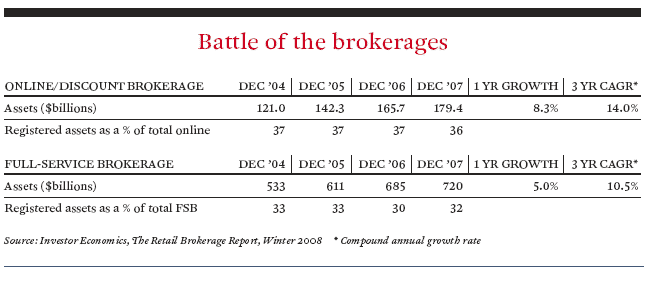Doityourself investors Watch those online broker fees The Globe and Mail
Post on: 6 Май, 2015 No Comment

The Globe and Mail
Published Friday, Nov. 28 2014, 7:26 PM EST
Last updated Saturday, Nov. 29 2014, 4:10 PM EST
As low commissions become the industry standard, online brokers are finding other ways to shore up revenue. Buyer beware
DIY investors fight a never-ending war on costs.
Many online brokers reduced the cost of trading stocks to below $10 from as much as $29 in 2014, which means the battle for low commissions is largely won. Lower stock-trading costs are supposed to lure new customers to online investing and prompt existing clients to buy and sell more stocks and exchange-traded funds more often. But we should expect brokers to hedge that bet on commissions by shoring up revenues in other ways.
These other online investing costs play a significant role in The Globe and Mail’s annual ranking of online brokers, the latest edition of which was published this week. Here are some costs besides stock-trading commissions that were factored into the ranking.
Fees charged to receive a paper account statement
Your monthly or quarterly accounts statements should be available online as PDF files that are typically archived for seven years. If you want a hard copy, you can print it at home. Prefer to have your statements mailed to you? A growing number of brokers will charge you for this service. Example: Qtrade Investor charges $6 a quarter, while TD Direct Investing charges $2 a mailing.
By all means, try fighting this fee if you want a paper statement. TD, for example, says it will waive the charge if a client has special needs that require accommodation.
Account maintenance and inactivity fees
Brokers used to have annual administration fees for small registered accounts, and leave cash accounts alone. Now, some have maintenance fees that apply to most account types (TFSAs generally are the exclusion). If your firm does have account maintenance fees, check for ways to avoid them. At RBC Direct Investing you can avoid the $25-a-quarter maintenance charge by, for example, having a minimum $15,000 in total assets at the firm, or by setting up a preauthorized contribution plan of at least $100 a month to an account at the firm, or by making three or more commission-paid trades during the quarter.
The last thing brokers want is for people to dump a small amount of cash in an account and not do anything with it. To discourage this, some have account inactivity fees that are charged on a quarterly basis. There are usually a few ways to avoid them – check with your broker.
At most brokerage firms, electronic communication network fees are charged only to clients who use platforms and services for active trading – up to and including day trading – rather than mainstream investing. One exception to this rule is Qtrade Investor, which was ranked No. 1 in the latest Globe brokerage ranking. Another is Questrade, an up-and-comer ranked fourth. Both of these firms may in some cases add ECN fees to regular commissions.
Check the details on ECN fees if you deal with these firms. Qtrade says these fees may be charged on trades of Canadian stocks where market orders or limit orders at the market price are used. A market order means you’ll pay or accept the market rate for a stock, while a limit order puts a ceiling on what you’ll pay and a floor on what you’ll accept. For trades of Canadian stocks at Questrade where ECN fees apply, expect to pay $0.0035 a share.
Mutual fund buy and sell commissions
Many firms have dropped all fees for buying and selling mutual funds, and that means you can buy pretty much any fund at all with no worries about commissions. However, some firms retain buy and/or sell fees for a small group of fund companies that typically pay little or no compensation to the dealers or advisers that sell their products.
These funds, sold by companies like Leith Wheeler, Mawer and Steadyhand, can be smart choices for do-it-yourself investors who want access to professional portfolio managers. This is all the more true if you can buy and/or sell these funds without any costs. Among the firms that do charge to trade this type of mutual fund, costs range from a low of $9.99 at Questrade to $45 at Disnat for purchases of Mawer funds. Aside from Questrade, brokers typically let you buy mainstream mutual funds at no cost.
Margin interest
Lending customers money to buy stocks on margin is a significant source of revenue for brokers. The standard rate among the big bank-owned firms is the prime rate, now at 3 per cent, plus 1.25 percentage points. Rates can be higher at smaller independent firms, and clients with large accounts may pay less.
Foreign exchange
Another money maker. If you’re investing in U.S.-listed stocks or exchange-traded funds, you’re familiar with the inflated exchange rate brokers use when converting Canadian dollars into U.S. currency. To get a snapshot of how these exchange rates vary from firm to firm, brokers were asked as part of the Globe broker ranking to show the total cost of buying $15,000 (U.S.) on the morning of Oct. 6. Large accounts may qualify for better rates than you’ll see in the accompanying chart.
One way to reduce forex fees is to buy TSX-listed ETFs that track U.S. indexes. Your invested dollars are converted into U.S. currency by the ETF company, which should apply a comparatively cheap wholesale rate.














